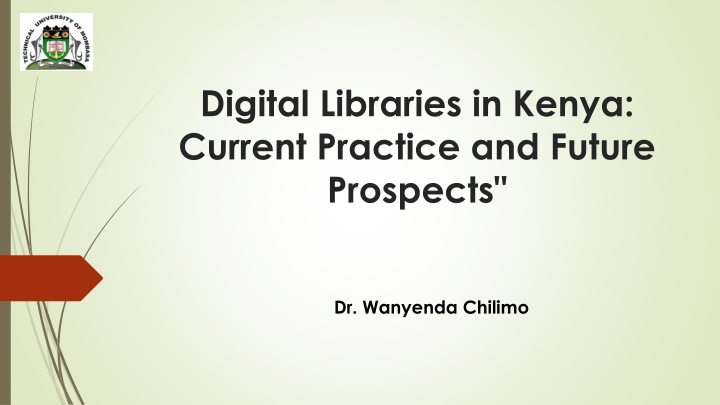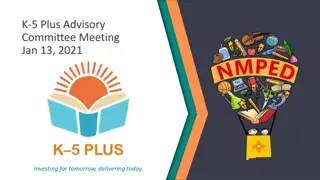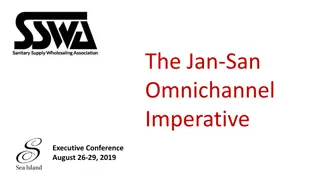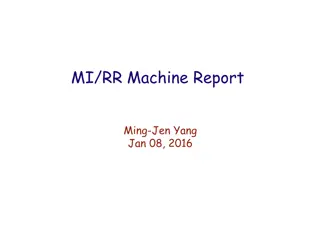
Digital Libraries in Kenya: Current Practice and Future Prospects
Explore the historical background and evolution of libraries in Kenya, including academic libraries and the development of digital resources. Discover the challenges and future possibilities in the Kenyan library landscape, focusing on e-resources, automated services, and institutional repositories.
Download Presentation

Please find below an Image/Link to download the presentation.
The content on the website is provided AS IS for your information and personal use only. It may not be sold, licensed, or shared on other websites without obtaining consent from the author. If you encounter any issues during the download, it is possible that the publisher has removed the file from their server.
You are allowed to download the files provided on this website for personal or commercial use, subject to the condition that they are used lawfully. All files are the property of their respective owners.
The content on the website is provided AS IS for your information and personal use only. It may not be sold, licensed, or shared on other websites without obtaining consent from the author.
E N D
Presentation Transcript
Digital Libraries in Kenya: Current Practice and Future Prospects" Dr. Wanyenda Chilimo
Outline Libraries in Kenya Historical background Academic Libraries in Kenya Digital Libraries E-resources (Access to E-journals and e-books) Automated library services Institutional repositories and Open access Challenges and future prospects Conclusion
Back ground The history of libraries in Kenya can be traced back to late 1800 when Kenya was still a British colony (Otike 1987) The first libraries were established to facilitate the activities of a newly established colony These libraries were later transformed into special libraries and research libraries, Examples of these include e.g. High Court Library - 1895 Agriculture and veterinary research libraries 1907 Attorney General Library 1914 Kenya Museum Library 1907 The earlies pubic libraries were Sir Bin Salim public library and reading Room - 1903 MacMillan Library - Established for the European Community - 1925
Back ground The first public library services started in the year 1948 with the establishment of Kenya National Library Services Board which was empowered to promote, equip, manage, maintain and develop libraries in Kenya (Otike 1987) The board was mandated to establish library services for citizens through out the country. Currently there are 64 branches in cities, towns and Counties through out Kenya In academic institutions the earlies libraries include Royal Technical College (1957) Currently University of Nairobi Egerton College (1940) Currently Egerton University MIOME (1948) Currently Technical University of Mombasa
Academic Libraries in Kenya Over the past few years, there has been a tremendous increase in the number of universities in Kenya The total number of universities in Kenya has increased from 13 in 2001 to, currently, 77 universities, which include public, private and constituent colleges (CUE 2022). The development of Digital libraries has gone hand in hand with the establishment of universities in Kenya as each university is required by law to have a well established and well functioning library system
Academic Libraries in Kenya The commission for university education (CUE) Standards for University Libraries in Kenya 2013, under LIBR/STD/03 states that A university library shall adopt and maintain Information Communication Technologies in information management and its operation In compliance with this standard and in order to meet to expectation of users (especially the youth) who are increasing becoming tech-savvy, establishing digital libraries becomes a matter of necessity.
Digital libraries Managed collection of information, with associated services, where the information is stored in digital formats and accessible over a network (Arms 2000) Digital Libraries are also referred to as electronic libraries, online libraries, virtual libraries, internet libraries, digital repository, digital collection etc. Libraries without walls, Virtual libraries or hybrid libraries. Materials in these libraries can include text, still images, audio, video. These can be digitized content like print or photographs as well as originally produced digital content The presentation will cover E-resources (Access to E-journals and e-books) Automated library services Institutional repositories and Open access
E-resources (Access to E-journals and e-books) Electronic resources (E-resources) are information sources available online and are accessible through the use of a computer. Traditionally, libraries have been a collection of books, journals, manuscripts and other print information, however this is changing due to advancements in ICTs Many academic libraries have transitioned into hybrid environments fulfilling the educational, recreational and information needs of their clients. Electronic resources provide users with timely information, being updated frequently. In addition, they provide wide-ranging links to additional resources Libraries in Kenya provide access to e-resources by subscribing to subject specific electronic database organised for ease search and retrieval of information
E-resources (Access to E-journals and e-books) Libraries in Kenya collectively subscribes to electronic resources by means of cost sharing as a way of coping with the raising cost of information resources All academic libraries are members of Kenya Libraries and Information Services Consortium (KLISC) KLISC negotiates for subscription rates and Licensing agreements for electronic resources on behalf of its members within reasonable financial considerations. Through membership to KLISC libraries have access to millions of full text electronic academic journals and books provided by publishers such as Ebsco host, IEEE, Emerald etc.
E-resources Challenges and future Prospects High cost of subscription to E-resources which makes some databases out of reach to Kenyan Universities e.g. Elsevier, Scopus and Web of science databases Underutilization of the resources by staff and students Inadequate skills among library staff hence the need for frequent training programs and capacity building Low bandwidth and inadequate ICT infrastructure within the universities which makes accessibility a challenge
Automated library services Majority of academic libraries in Kenya have automated their services Through automation libraries are able to utilize information communications technologies (ICT) to replace manual systems. This bring efficient and effectiveness in operations A study done by Adera 2013 shows that 67% of libraries in Kenya were using KOHA as their library software The main reason for this trend is the cost-effectiveness associated with the use of open source systems. In most cases, academic libraries in Kenya are inadequately funded but are under pressure to provide quality library services to their users. This scenario makes open source systems an attractive option for these libraries Other advantages of using Koha include lower initial and ongoing costs, the absence of vendor lock-ins and allowing for greater flexibility.
Automation - Challenges and future Prospects However, managing open source LMSs also comes with challenges. The main challenge is lack of quality support services or a dedicated vendor company to maintain the systems for the libraries Though free and paid Koha support services are also available through the Koha Kenya Community (2014), However this is not adequate, Libraries using Koha are still faced with challenges including: lack of skills, knowledge, and competencies to effectively use Koha. Inability to effectively use all the modules in Koha because of a lack of skills. The modules that are mainly used are circulation and cataloguing modules. Difficulties upgrading and backing up the Koha database. Difficulties involving integrating KOHA with other systems in the universities e.g. Finance, student management system Inadequate hard ware, networking infrusttacture and other IT facilities
Institutional Repositories and open access Institutional repositories (IRs) have emerged alongside the open access (OA) initiative on scientific literature which advocates for free, online access to digital scholarly materials (Ferreira et al. 2008) Institutional repositories are important tools in facilitating global access to the institutional generated intellectual output and making it visible globally Open access services through institutional repositories have the potential to maximize access and impact, and accelerate the dissemination of research output generated from African countries This will in turn improve visibility of African researchers to global knowledge (Jones, 2018)
Institutional Repositories and open access Statistics from global Directory of Open Access Repositories (OpenDOAR) shows that: Europe has 1,938 Repositories America has 1,204 Repositories Asia has 842 Repositories Africa has 213 IRs Oceania has 101 Repositories (OpenDOAR, 2019). In Africa OpenDOAR places Kenya as the second-largest contributor of Repositories in Africa, after South Africa based on the number of repository counts
Institutional Repositories and open access Kenya has experienced rapid development of IRs over the past few years The number of IRs in Kenya listed in OpenDOAR rose from two in 2009 to 46 in 2022. In addition, many more universities are in the process of developing their repositories. Some of them are already on the World Wide Web (or Web) but not yet listed in OpenDOAR, and some still operate on their institutions local area network (LAN)
Institutional Repositories in Kenya From 2000 Kenya Library and Information Services Consortium (KLISC) with support form International Network for Advancing Science and Policy (INASP) played an important role in encouraging the implementation of institutional repositories in Kenya (Ratanya 2017) KLISC conducted rigorous training in Open Access and Institutional Repositories to sensitize KLISC member institutions. In addition, KLISC conducted Open Access workshops and conferences through the support of Eifl.net and INASP.
Institutional Repositories in Kenya Majority of the institutions that participated in these workshop have established or are in process of establishing IR This greatly contributed to the success of institutional Repositories in Kenya Majority of the repositories in Kenya are established using the Dspace software KLISC is currently conducting similar workshops on various related topics including: Open Science, open data, open journal system (OJS) etc.
IR and OA at Technical University of Mombasa Technical University of Mombasa (TUM) established it first IR in 2015 Currently TUM has three repositories The University repository available at http://ir.tum.ac.ke/ Content available in this repository include journal articles, book chapter, Thesis and Dissertation, Conference proceedings etc The university intellectual output The past examination paper databank https://erepository.tum.ac.ke/ Coast week Newspaper archives http://41.89.128.49/ A collaborative project developed by Technical University of Mombasa and Coastweek, a community newspaper that presents a unique rich historical legacy of the Coast region of Kenya. The newspaper was published weekly from 10th November 1978 to 31st December, 2018
IR and OA at Technical University of Mombasa The University is hosting a scholarly Journal called the Multidisciplinary Journal of Technical University of Mombasa https://journals.tum.ac.ke The journal is hosted using the Open Journal System Technical aspects of the journal management are handled by the library. These include : Installation of the Journal management system OJS system maintenance, upgrading, back up and server administration ISSN Registration DOI registration and metadata Registration with Cross Ref
Challenges and future Prospects Lack of awareness of open access institutional repositories among researchers and academics Inadequate content in the repositories: Most university have policies that mandates academics to deposit copies of their publications in the repositories, however, enforcing these mandates is a challenge Low level of performance of the repositories. Study by Adam and Kaur (2022) reported that, globally, African IRs have not been able to penetrate into the top 100 ranked IRs by Transparent Ranking, though four have managed to be listed in the top 200. (SA and Sudan) There is need to embrace the culture and practice of open science by adopting and implementing other open science element based on UNESCO recommendation e.g. open data, open evaluation etc
Conclusion Despite the challenges libraries in Kenya are making some progress in implementing digital libraries A lot of progress made so far has been through partnership and collaborations with institutions, projects within and outside Kenya My institution is continuously seek such partnerships for sharing experiences, capacity building and mutual benefits between institutions
References Adam, U. A., & Kaur, K. (2022). Institutional repositories in Africa: Regaining direction. Information Development, 38(2), 166 178. https://doi.org/10.1177/02666669211015429 Adera, B. A. (2013). Feasibility of adaptation of open source ILS for libraries in Kenya: a practical evaluation. The Electronic Library. Arms, W.Y. (2000), Digital Libraries, MIT Press, Cambridge, MA CUE (2014) Standards for University Libraries in Kenya 2014. https://www.cue.or.ke/index.php?option=com_phocadownload&view=category&id=16:standards-and- guidelines&Itemid=187 CUE (2022). Status of Universities. https://www.cue.or.ke/index.php?option=com_content&view=article&id=21&Itemid=189 Ferreira, M., A. A. Baptista, E. Rodrigues and R. Saraiva. 2008. Carrots and sticks: Some ideas on how to create a successful institutional repository. D-Lib Magazine 14(1/2) Jones W. R. (2018). Institutional Repositories and Usage: Thoughts on Realized and Potential Value. Public Services Quarterly, 14(4): 386 391 OpenDOAR, (2019). Repositories by Countries https://v2.sherpa.ac.uk/opendoar/ Otike J (1987). Development of libraries in Kenya. http://www.innovation.ukzn.ac.za/InnovationPdfs/No28pp1-8Otike.pdf Retrieved on 27th May 2010. 28. Ratanya F. C. (2017). Institutional repository: access and use by academic staff at Egerton University, Kenya. Library Management, 38(4/5): 276 284.
Appreciation Transcultural Perspectives in Art and Art Education (TPAAE) - The project has received funding from the European Union s Horizon 2020 research and innovation programme under the Marie Sk odowska-Curie grant agreement No 872718 Academy of Art in Szczecin (Poland) coordinator National Museum in Szczecin (Poland) West Pomeranian University of Technology libraray
THANK YOU Dzi kuj Ci





















